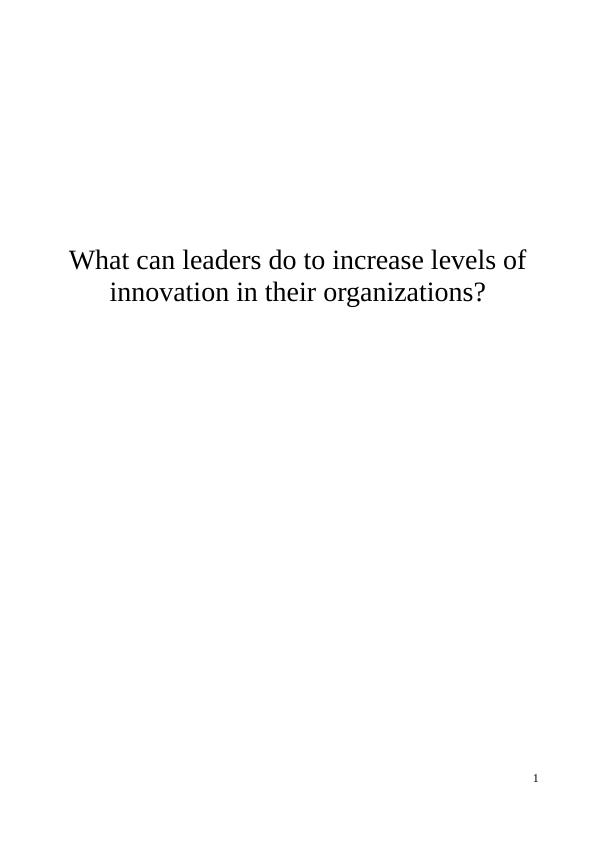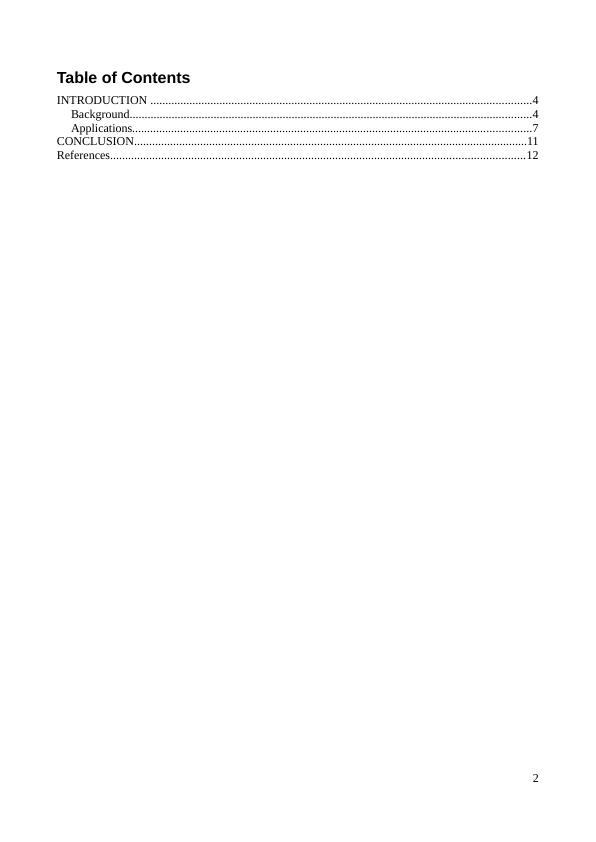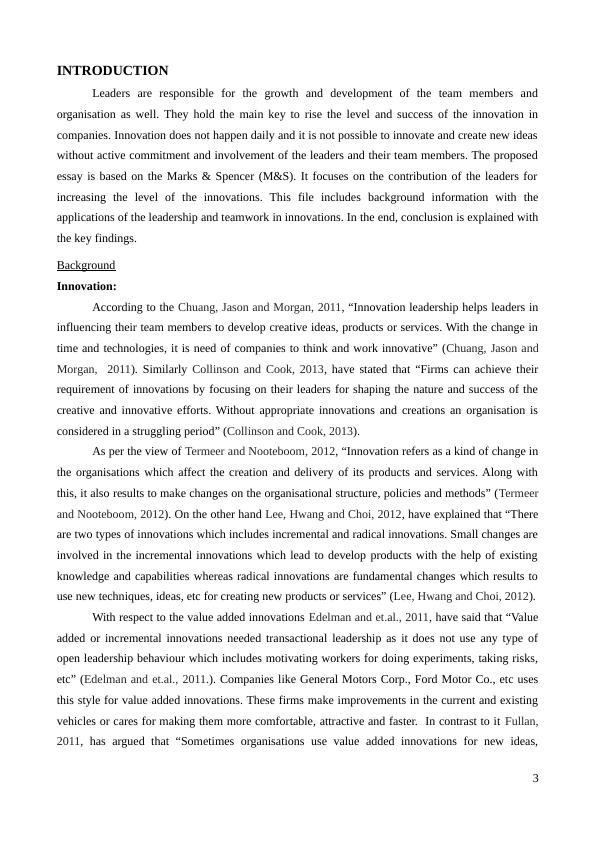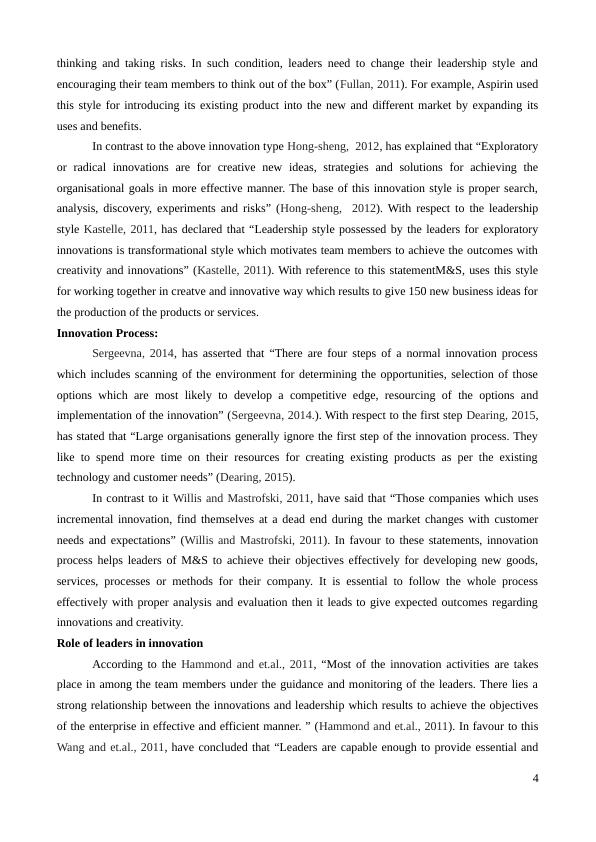Essay On Marks & Spencer (M&S) | Leaders & Innovations
12 Pages4462 Words80 Views
Added on 2020-02-14
Essay On Marks & Spencer (M&S) | Leaders & Innovations
Added on 2020-02-14
ShareRelated Documents
What can leaders do to increase levels ofinnovation in their organizations?1

Table of ContentsINTRODUCTION ...............................................................................................................................4Background......................................................................................................................................4Applications.....................................................................................................................................7CONCLUSION...................................................................................................................................11References..........................................................................................................................................122

INTRODUCTION Leaders are responsible for the growth and development of the team members andorganisation as well. They hold the main key to rise the level and success of the innovation incompanies. Innovation does not happen daily and it is not possible to innovate and create new ideaswithout active commitment and involvement of the leaders and their team members. The proposedessay is based on the Marks & Spencer (M&S). It focuses on the contribution of the leaders forincreasing the level of the innovations. This file includes background information with theapplications of the leadership and teamwork in innovations. In the end, conclusion is explained withthe key findings. BackgroundInnovation: According to the Chuang, Jason and Morgan, 2011, “Innovation leadership helps leaders ininfluencing their team members to develop creative ideas, products or services. With the change intime and technologies, it is need of companies to think and work innovative” (Chuang, Jason andMorgan, 2011). Similarly Collinson and Cook, 2013, have stated that “Firms can achieve theirrequirement of innovations by focusing on their leaders for shaping the nature and success of thecreative and innovative efforts. Without appropriate innovations and creations an organisation isconsidered in a struggling period” (Collinson and Cook, 2013). As per the view of Termeer and Nooteboom, 2012, “Innovation refers as a kind of change inthe organisations which affect the creation and delivery of its products and services. Along withthis, it also results to make changes on the organisational structure, policies and methods” (Termeerand Nooteboom, 2012). On the other hand Lee, Hwang and Choi, 2012, have explained that “Thereare two types of innovations which includes incremental and radical innovations. Small changes areinvolved in the incremental innovations which lead to develop products with the help of existingknowledge and capabilities whereas radical innovations are fundamental changes which results touse new techniques, ideas, etc for creating new products or services” (Lee, Hwang and Choi, 2012).With respect to the value added innovations Edelman and et.al., 2011, have said that “Valueadded or incremental innovations needed transactional leadership as it does not use any type ofopen leadership behaviour which includes motivating workers for doing experiments, taking risks,etc” (Edelman and et.al., 2011.). Companies like General Motors Corp., Ford Motor Co., etc usesthis style for value added innovations. These firms make improvements in the current and existingvehicles or cares for making them more comfortable, attractive and faster. In contrast to it Fullan,2011, has argued that “Sometimes organisations use value added innovations for new ideas,3

thinking and taking risks. In such condition, leaders need to change their leadership style andencouraging their team members to think out of the box” (Fullan, 2011). For example, Aspirin usedthis style for introducing its existing product into the new and different market by expanding itsuses and benefits. In contrast to the above innovation type Hong-sheng, 2012, has explained that “Exploratoryor radical innovations are for creative new ideas, strategies and solutions for achieving theorganisational goals in more effective manner. The base of this innovation style is proper search,analysis, discovery, experiments and risks” (Hong-sheng, 2012). With respect to the leadershipstyle Kastelle, 2011, has declared that “Leadership style possessed by the leaders for exploratoryinnovations is transformational style which motivates team members to achieve the outcomes withcreativity and innovations” (Kastelle, 2011). With reference to this statementM&S, uses this stylefor working together in creatve and innovative way which results to give 150 new business ideas forthe production of the products or services. Innovation Process: Sergeevna, 2014, has asserted that “There are four steps of a normal innovation processwhich includes scanning of the environment for determining the opportunities, selection of thoseoptions which are most likely to develop a competitive edge, resourcing of the options andimplementation of the innovation” (Sergeevna, 2014.). With respect to the first step Dearing, 2015,has stated that “Large organisations generally ignore the first step of the innovation process. Theylike to spend more time on their resources for creating existing products as per the existingtechnology and customer needs” (Dearing, 2015). In contrast to it Willis and Mastrofski, 2011, have said that “Those companies which usesincremental innovation, find themselves at a dead end during the market changes with customerneeds and expectations” (Willis and Mastrofski, 2011). In favour to these statements, innovationprocess helps leaders of M&S to achieve their objectives effectively for developing new goods,services, processes or methods for their company. It is essential to follow the whole processeffectively with proper analysis and evaluation then it leads to give expected outcomes regardinginnovations and creativity. Role of leaders in innovationAccording to the Hammond and et.al., 2011, “Most of the innovation activities are takesplace in among the team members under the guidance and monitoring of the leaders. There lies astrong relationship between the innovations and leadership which results to achieve the objectivesof the enterprise in effective and efficient manner. ” (Hammond and et.al., 2011). In favour to thisWang and et.al., 2011, have concluded that “Leaders are capable enough to provide essential and4

End of preview
Want to access all the pages? Upload your documents or become a member.
Related Documents
Creativity, Innovation & Designlg...
|6
|1242
|67
Leadership Traitslg...
|4
|797
|349
Leadership and Management: A Personal Reflectionlg...
|8
|1659
|485
Understanding and Leading Changelg...
|9
|569
|36
